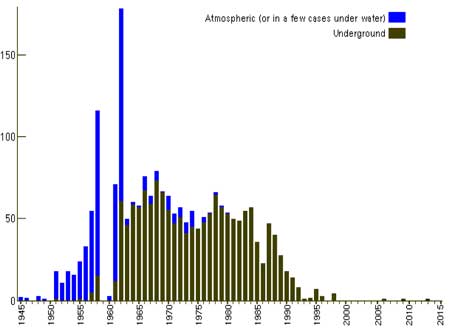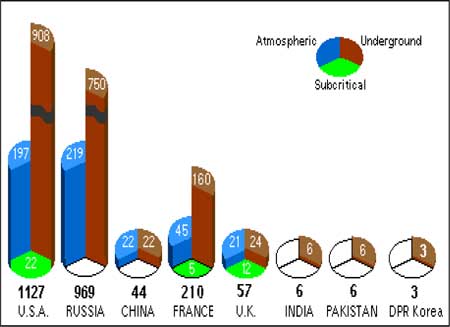Nuclear weapon using the energyAbility to do work or diffuse heat. The unit of energy is th... released during the fissionSee 'nuclear fission'. of U-235 or Pu-239. The explosive force of a nuclear weapon is indicated in kilotonnes (kt) or megatonnes (Mt) of TNT equivalents (TNT (trinitrotoluol) is a chemical explosive). The bombs dropped on Hiroshima (U-235 bomb) and Nagasaki (Pu-239 bomb) had an explosive energyAbility to do work or diffuse heat. The unit of energy is th... equal to 13 and 22 kt TNT. In each case about 1 kg fissionSee 'nuclear fission'. material was fissioned in one millionth of a second. A minimum mass of fissionSee 'nuclear fission'. material is required for a nuclear blasting charge, e.g. 52 kg of U-235. The highly developed weapon technology in the nuclear weapon countries partly enables lower values, e.g. 15 kg and less for metallic U-235. An ignition device is also required to shoot these fissionSee 'nuclear fission'. materials together to a criticalA reactor is critical when due to nuclear fission as many ne... configuration within a very short periodreactor period so as to initiate the chain reactionSelf-perpetuating reaction. In a fission chain reaction, a f.... Experts quote a velocity of some kilometres per second for weapon plutoniumPlutonium - the 94th element in the classification of elemen... and a multiple of this impact velocity is necessary for reactorSystem used to initiate, maintain and control a fission chai... plutoniumPlutonium - the 94th element in the classification of elemen... with its high share of other plutoniumPlutonium - the 94th element in the classification of elemen... isotopes. See ‘hydrogen bomb’.
|
Type of fissionSee 'nuclear fission'. |
Quantity in kg |
|
| as a metal |
as an oxide |
|
| Weapon plutoniumPlutonium - the 94th element in the classification of elemen... | 10 | 30 |
| ReactorSystem used to initiate, maintain and control a fission chai... plutoniumPlutonium - the 94th element in the classification of elemen... | >13 | 40 |
| 93% enriched U-235 | 52 | 100 |
| 3% enriched U-235 (LWR-fuel) | not possible | not possible |
| U-233 | 16 | 40 |
Estimated minimum quantity of fissionSee 'nuclear fission'. material for nuclear blasting charges.
According to UNSCEARUnited Nations Scientific Committee on the Effects of Atomic... 504 atmospheric explosion (plus 39 safety tests) and 1879 underground explosions were carried out till mid of Februar 2013.



